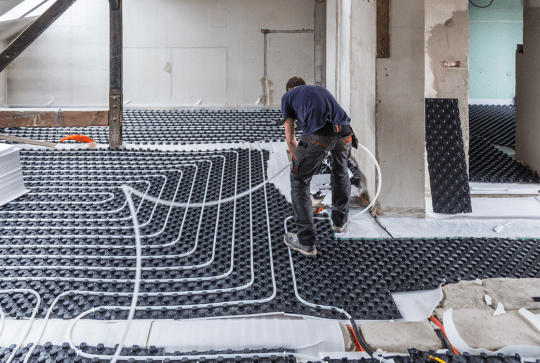21
Oct 2024
Can you Have Underfloor Heating Upstairs?
Underfloor heating (UFH) has become a popular choice for homeowners looking to achieve greater comfort and energy efficiency. While it is commonly associated with ground floors, many people wonder if it’s possible to install underfloor heating upstairs. The good news is, yes, you can absolutely have underfloor heating on upper floors, and it comes with a range of benefits. In this blog post, we’ll explore why underfloor heating is a fantastic option for upstairs spaces and what to consider when planning your installation.
Benefits of Underfloor Heating Upstairs
- Maximise Space
One of the major advantages of underfloor heating upstairs is that it eliminates the need for bulky radiators. This allows you to maximise the usable space in rooms like bedrooms and bathrooms, giving you greater freedom when it comes to furniture placement and interior design. - Enhanced Comfort
Underfloor heating provides an even distribution of warmth, which can be especially beneficial upstairs where rooms may be cooler due to heat rising from the lower floors. By ensuring consistent temperatures, you’ll experience better overall comfort. - Energy Efficiency
Compared to traditional radiators, underfloor heating is more energy-efficient as it operates at lower temperatures while still providing adequate heat. This can help lower your energy bills and reduce your home’s carbon footprint, making it a great option for eco-conscious homeowners. - Silent Operation
Unlike some traditional heating systems that produce noise, underfloor heating operates silently. This is a particularly appealing feature for upstairs bedrooms, where peace and quiet are essential for restful sleep.
Types of Underfloor Heating Suitable for Upper Floors
There are two primary types of underfloor heating: electric and water-based systems. Both can be installed upstairs, but the choice depends on your needs and the structure of your home.
- Electric Underfloor Heating
Electric UFH systems are typically easier to install upstairs because they are lightweight and do not add significant weight to the floor. They consist of electric heating mats or cables that are installed directly beneath the flooring. This type of system is ideal for smaller areas like bathrooms or en-suites but can also be used in larger bedrooms. - Water-Based Underfloor Heating
Water-based systems, also known as wet UFH, use pipes that circulate warm water beneath the floor. These systems are more complex to install on upper floors, particularly in older properties, as they require a bit more structural work to accommodate the pipes. However, they can be a very efficient heating solution, especially in new builds or during major renovations.
Things to Consider Before Installing Underfloor Heating Upstairs
- Flooring Type
The type of flooring you choose for upstairs rooms can affect the performance of your underfloor heating system. UFH works best with materials that conduct heat well, such as tile, stone, or engineered wood. Carpet can also be used, but it’s important to ensure the tog rating is suitable for underfloor heating to prevent heat from being blocked. - Insulation
Proper insulation is crucial when installing underfloor heating upstairs. Insulating beneath the heating system ensures that heat is directed upwards into the room rather than being lost into the floor below. Good insulation will improve efficiency and ensure you get the most out of your UFH system. - Weight and Floor Load
If you’re opting for a water-based system, you need to ensure that your upper floors can handle the additional weight of the pipes and screed. Consulting with a structural engineer or UFH specialist is recommended to assess whether reinforcements are necessary. - Professional Installation
Installing underfloor heating upstairs, particularly a water-based system, requires careful planning and professional installation. Working with experienced installers will ensure that your system is safe, efficient, and suited to the specific needs of your home.
Conclusion
Underfloor heating can be installed upstairs with ease, offering benefits such as improved comfort, energy efficiency, and more flexible room design. Both electric and water-based systems are viable options, with electric systems being the simplest for upper floors. By considering factors such as your flooring, insulation, and the weight of the system, you can enjoy the luxury of underfloor heating throughout your home.
At JCW Underfloor Heating, we offer a range of solutions for both ground and upper floors. If you’re interested in learning more about the best underfloor heating system for your upstairs rooms, get in touch with us today!
